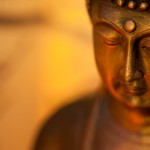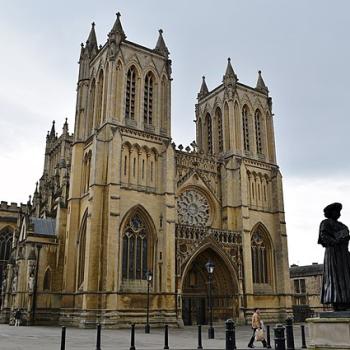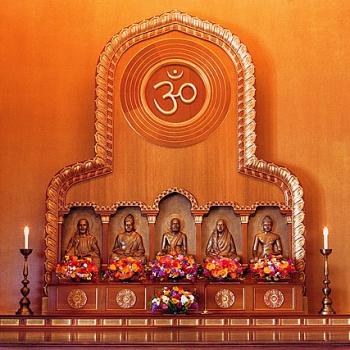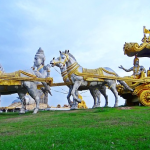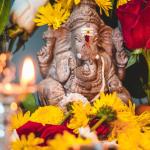The Upanishads are 108 in total. However, the principal or main Upanishads are 12 in number. The PDF downloads below include Hindi, Sanskrit, Malayalam and English versions. The English version includes only the 12 principal Upanishads. The Hindi, Sanskrit and Malayalam versions include all 108 Upanishads.
108 Upanishads PDF downloads – English, Hindi, Sanskrit, Malayalam
English
Sanskrit (149mb file – Right-click and Save-As)
Hindi – Part 1, Part 2, Part 3 (Part 1 and Part 2 are in djvu format. You will need the djvu reader to read them. It can downloaded for free here.
Malayalam
Book Details
English
The Principal Upanishads
by Sri Sarvepalli Radhakrishnan
Hindi
The 108 Upanishads
by Pt. Shriram Sharma Acharya
Sanskrit
The 108 Upanishads with Commentary
by Ramachandrendra Sarasvati
Malayalam
The 108 Upanishads
by V Balakrishnan and Leela Devi
More Free Stuff
 Vairagya is a collection of sacred chants that include Nirvana Shatakam, Aum Namah Shivaya and Guru Paduka Stotram.
Vairagya is a collection of sacred chants that include Nirvana Shatakam, Aum Namah Shivaya and Guru Paduka Stotram.
 “Shiva – Ultimate Outlaw” is in the words of yogi and mystic Sadhguru, and gives us a dynamic and unique look at the many aspects of Lord Shiva, that are not found elsewhere.
“Shiva – Ultimate Outlaw” is in the words of yogi and mystic Sadhguru, and gives us a dynamic and unique look at the many aspects of Lord Shiva, that are not found elsewhere.
 The Lord Shiva app is a one-stop guide to Lord Shiva. Get chants, stories, temples, wallpapers and more.
The Lord Shiva app is a one-stop guide to Lord Shiva. Get chants, stories, temples, wallpapers and more.
Download Android App
The Relationship of the Upanishads and the Vedas
The Upanishads are extracts of Vedanta, or material from the Vedas, and represent the philosophical essence of the Vedas. They are considered some of the most refined pieces of philosophical literature not just in India, but indeed in the world. The Upanishads are generally believed to be 108 in number. Of these, 10 of the earliest or Dashopanishads are considered the mukhya Upanishads and are accepted to be of chief importance. They were commented upon and annotated by Adi Shankaracharya. Most of these are found towards the ends of the Brahmana and Aranyaka texts. According to the muktika tradition or the Muktopanishad, there are 98 other Upanishads aside from the chief ones, totaling 108. Later, from the 15-19th centuries, other texts were composed and were claimed to be Upanishads. This resulted in different books giving varying numbers for the Upanishads, some running up to 300. Generally though, the number is accepted as 108.
Each of the Upanishads belong to different periods of Indian history and are the works of different authors. The earliest of the Upanishads are known to be pre-buddhistic, written within 1,000 B.C. and 300 B .C. and culminating in the Mauryan period. The Mauryan period was in fact a golden age when many of the ancient Indian texts were put down in writing, probably in reaction to the rise of Buddhism and Jainism. The Bhagavad Gita, the epics the Ramayana and Mahabharat, and the Brahmanas, and the four Vedas were put into writing in this period, the culmination of a hoary millennia-long oral tradition which was passed down from Guru to Shishya or Master to disciple.
The Significance of the Upanishads
The main Upanishads are:
(1) Brihadaranyaka
(2) Chandogya
(3) Kena
(4) Katha
(5) Isha
(6) Mandukya
(7) Svetasvatara
(8) Maitrayaniya
(9) Prashna
(10) Aitreya
(11) Taittiriya
(12) Kaivalya
Of these, the oldest of the Vedas, the Rig Veda contains the Aitreya Upanishad. The next in antiquity is the Sama Veda which contains the Kena Upanishad and Chandogya Upanishad. Next comes the Yajur Veda which contains the most: four of the Upanishads namely, Katha, Taittiriya, Brihadaranyaka and Svetasvatara. The most recent of the Vedas is the Atharvana Veda which contains the Mandukya and Kaivalya Upanishad.
This little article is an attempt to place the main the principal Upanishads within the reach of every man and woman.
The Upanishads are magnificent movements of ancient Indian wisdom, being the grand outpourings of the spiritual experiences of those unique seekers of truth who, having risen above the chaos of ritualism and word spinning of scholastic philosophy, saw the truth directly through intuitive insight and thus gave to the thinking world what no philosophy based merely on logical reasoning could possibly give. The aim of the authors in writing these scriptures was not, however, so much propagation of their metaphysical findings as to bring peace and freedom to anxious and struggling humanity through right living based on spiritual experiences.
Who can doubt the fact that spiritual inheritance of the Hindus is as great, if not greater than, that of any living nation of the world? And yet no people are so poor in truly religious life as Hindus are at the present time. Is it not tragic that with such a treasure house as the as the Upanishads at our disposal, we are still weltering ignominiously in the quagmire of gross materialism and superstitious rituals.
It has been well said that “ideas are forces and they must be broadcasted if the ageing to death of a nation is to be avoided”. It is just this truth which has so long been ignored by the Hindu society with regard to the religious life of most of its members. Instead of broadcasting the sublime ideas and ideals of our ancient seekers, we had kept them confined in books which only a few could understand and had taught them in institutions to which still fewer could find access.
Our greatest need at the present time is, therefore, the dissemination of those noble teachings of our sacred scriptures which when reduced to practice can enrich human life and can, at the same time, make life thus enriched subservient to the achievement of social ends. It will, indeed, be strange, if the spirit of supreme wisdom of our Rishis which could at one time touch the deepest springs of human personality to such fine issues, should have lost its power of regenerating the present generations. Let us then go back without any farther delay to our ancient and ever-fresh springs of spiritual vitality which have always been and can still be the best restoratives of our lost vigour.
The message of the Upanishads, as given in this article, is meant neither for scholars nor for philosophers. It is a book written by a layman for laymen. The idea is simply to bring home to an average English knowing man and woman the importance and use of those principles of spiritual import which are indispensable both for daily worship and all round uplift.
Thanks to the selfless and unremitting labours of Rishi Dayanand and other founders of modern Hindu religious movements, there is a noticeable and increasing interest everywhere in the study of classical religious literature of ancient India. If the present humble effort in the form of this little article can tend to stimulate this interest even to a small extent, the author will have been amply rewarded.
Any reader of the Upanishads must acknowledge their debt of gratitude to Dr. S. Radhakrishnan, Professor Robert Ernest Hume, Professor Joseph-Nadin Rawson, and others upon whose scholarly writings modern translations of the original Sanskrit texts draw so amply. Dr. Radhakrishnan’s interpretations have been particularly helpful because they serve as great correctives both in the case of Western scholars, who at times are unable to enter into the spirit of foreign religion, and in the case, also of learned but orthodox Pandits of India who stick too closely to the traditional meanings and interpretations of the original texts.
Professor Rawson’s translation of Katha Upanishad is a rich mine of information regarding the different views held about meanings and interpretations of Katha Upanishad. Dr Hume’s translation of the thirteen Principal Upanishads besides giving translation in English of the original Sanskrit texts with an outline of the philosophy of the Upanishads has an annotated bibliography as a very valuable appendix.
Brief Contents of the Upanishads
THE GREAT RIDDLE AND ITS SOLUTION
(a) Monism – The Great Riddle
(b) The Solution
III. RITUALS
IV. OUTLOOK ON LIFE
(a) Life is a Pilgrimage
(b) An Opportunity for Work and Worship
(c) Optimistic
V. Moksha or Mukti (Salvation)
VI. PATHWAYS TO REALITY
(a) Faith in the Aitreya Brahmana
(b) Need of a Guru
(c) Yoga Sadhana in the Aranyakas
VII. DEVOTION (BHAKTI)
(a) Renunciation
(b) Divine Grace
(c) Truthfulness
(d) Austerity
(e) Sound Knowledge
(f) Brahmacharya
(g) Stainless Life
The Upanishads in Western Thought and Philosophy
Quoted in R E. Hume’s translation of The Thirteen Principal Upanishads.
“When we read with attention the poetical and philosophical movements of the East, above all those of India which are beginning to spread in Europe, we discover there so many truths, and truths so profound and which make such a contrast with the meanness of the results at which the European genius has sometimes stopped, that we are constrained to bend the knee before that of the East, and to see in this cradle of the human race the native land of this highest philosophy. — Victor Cousin.
“The great Upanishads are the deep still mountain tarn, fed from the pure waters of the everlasting snows, lit by clear sunshine, or by night mirroring the high serenity of the stars […] On the tree of Indian wisdom, there is no fairer flower than the Upanishads, no finer fruit than the Vedas and Vedanta Philosophy.” — Paul Deussen.
“I have found them wise, beyond all others; and beyond all others, filled with that very light which makes all things new… That glowing heart within us, we are beginning to guess, is the heart of all things, the everlasting foundation of the world.” — Johnston Charles.
“In India our religion will not and never strike root: the primitive wisdom of the human race will never be pushed aside there by the events of Galilee. On the contrary, Indian wisdom will flow back upon Europe, and produce a thorough change in our knowing and thinking”. — Arthur Schopenhauer.
“In the whole world, there is. no study so beneficent and elevating as that of the Upanishads. It has been the solace of my life. It will be the solace of my death.” — Arthur Schopenhauer.
“If these words of Schopenhauer require endorsement I shall willingly give it as the result of my own experience during a long life devoted to the study of many philosophies and many religions”. — Max Muller.
“If I were to ask myself from what literature we here in Europe, who have been nurtured almost exclusively on the thoughts of Greeks and Romans, and of one Semitic race, the Jewish, may draw that corrective which is most wanted in order to make our inner life more perfect, more comprehensive, more universal, in fact more truly human, a life not for this life only, but a transfigured and eternal life—again I should point to India.” — Max Muller.
Monism in the Upanishads
The Great Riddle
The questions, how and why the universe and life have come into being and what will be their destiny, have been the enigma of ages.
“What is the cause of Brahman? Whence do we originate? By what do we live and on what established? Upheld by what in pleasure and its reverse
Live we our respective lives, O Brahman Knowers?” So enquires the author of Svetasvatra Upanishad.
And the following verse from Brihad-Aranyaka Upanishad repeats the same enquiry:
“That, O, Yajnavalkya, which is above the sky, that which is beneath the earth, that which is between these two, sky and earth, that which people call the past and the present and the future—across what is that woven warp and woof.
In the Kena Upanishad the disciple asks :—
“At whose wish does the mind, sent forth, proceed on what errand ? At whose command does the first breath go forth, at whose wish do we utter the speech ? What God directs the eye or. the ear?”
The Great Riddle in the form of above questions has been engaging the serious attention of thoughtful people all the world over for centuries past, and the Indian sages of old were the first to’ accent the challenge of this riddle.
“The Upanishads are the first recorded attempts of the Hindus at systematic philosophising. Their ancient documents constitute the earliest written presentation of their efforts to constitute the world experience as a rational whole. Furthermore, they have continued to be generally accepted authoritative statements, with which every subsequent orthodox philosophic formulation has had to show itself in accord, or at least not in discord.”
Attempts are sometimes made to belittle the importance of these enquiries by emphasising the short span of human ; life. But somehow the human mind does not rest satisfied; with these attempts. Try as we may, the cry will always go up from the heart of man: ‘What is it all about?”
Venerable Bede of old England has dismissed these enquiries by likening life to the passage of a sparrow flying from the darkness outside to darkness again through a lighted hall. But Bede did not take into consideration the fact that the interval of flight in the lighted hall, though short, was the occasion of so many happenings, both pleasant and unpleasant, to the poor human sparrow that it cannot help feeling restless for the solution of the question “how, why and what for—these occurrences?”
The Upanishads reveal in a marked degree the restlessness and stirring of the human mind to grasp the meaning and essence of life and its relation with the universe. Fortunately their authors had not only the driving force of the intense inner urge but also the unique mental and emotional equipment to tackle the great problem with which they were faced. They combined piety with thought and deep devotion with constant intellectual effort. They had thus acquired that unswerving mental efficiency, poise and patience which are indispensable pre-requisites for concentration and meditation. Their one devouring passion was to get at the truth and it was to satisfy this inner urge that they spent laborious days and sleepless nights.
The sages of the Upanishads
Besides the intellectual and emotional faculties with which the authors of the Upanishads were so well endowed by nature and which they had developed and trained so efficiently, they had through co-ordination and fusion of the divergent elements of personality coupled with spotlessly chaste and austere life, acquired that spiritual insight which alone can penetrate beneath the surface and enable the aspirant to have a direct perception of the underlying reality. They were thus “like babes who babble of the joy of vision of the Mother and the ecstasy into which that vision has thrown them. They came at the end of their spiritual strivings in this very life to a spring—cool, clear, life-giving—and were content to describe the spring as they saw it”.
“Unfortunately, we know very little of the lives of the great thinkers whose reflections are embodied into Upanishads. So careless were they of personal fame and so anxious for the spread of truth, that they fathered their views on the honoured deities and heroes of the Vedic period”. This is, a clear indication of the high-mindednesss and inner richness “of these noble souls. The only thing of value in their eyes, as revealed by a study of their great works, the Upanishads, was the discovery of truth and living in the light of that truth. Fortunate is the individual who profits spiritually by the ennobling and inspiring influence of these saints and sages through their great works.
Svetaketu in the Upanishads
“By knowing God there is a falling off of all fetters;
With distresses destroyed, there is cessation of birth and death.
By meditating upon Him there is the third stage at the dissolution of the body. Even universal lordship, being absorbed, his desire of the body is satisfied.”
“As birds resort to a tree for a resting place, even so every thing here resorts.”
Well could the sage of Prasna Upanishad sing with the poet.
“Like a flock of homesick cranes flying night and day back to their mountain nests let all my life take its voyage to its eternal home in one salutation to thee”.
The Mundaka and Svetasvatra Upanishads declare the individual and universal souls as different entities but this is not the view of all the Upanishads. They do not all speak in the same tone. Their authors are many and they do not all belong to the same period. Some of the sages such as those of Brihad-Aranyaka and Chandogya Upanishads teach pure monism and the existence of Absolute Brahma, while some others proclaim the Universal Soul as distinct from the individual soul.
The following dialogue quoted from Brihad-Aranyaka Upanishad shows clearly the essential oneness of the two souls:
“Ushasta Chakrayana questioned him (Yajnavalkya). “Yajnavalkya”, said he, “Explain to me him who is the Brahma present and not beyond our ken, him who is the soul in all things”.
“He is your soul, which is in all things”.
“Which one, O Yajnavalkya, is in all things”
“He who breathes in your breathing-in (prana) is the Soul of yours which is in all things.”
In a dialogue between Uddalaka and his son Svetaketu, the father tries in various ways to explain to his son that there is a spiritual Reality underlying all existence and that this supreme Reality is the root of not only all the objective but of the entire subjective existence also.
“Bring the fruit of Nyagrodha tree, break it. What do you find ?” says the father.
“The seeds,” replies the son.
“Break one of the seeds and tell me what you do see cont’inues the father.
“Nothing”, replies the son.
The father then explains: “My son, that subtle essence which you do not see there, of that very essence this great Nyagrodha tree has come into existence. Believe me, my dear, that which is the finest essence — this whole world has that for its soul. That is Sat, That is Atman, That is Paramatman. That art thou, Svetaketu – Tatvam Asi”.


